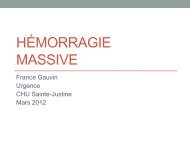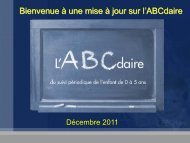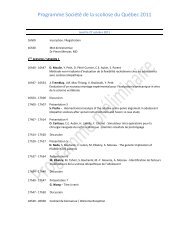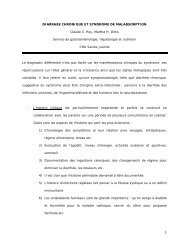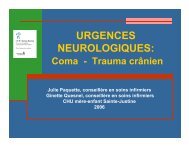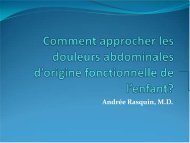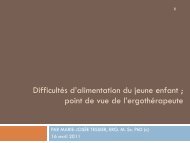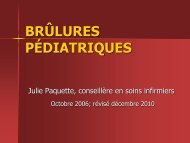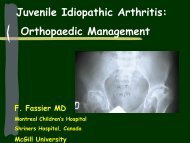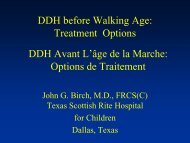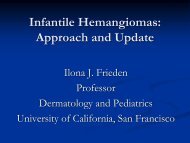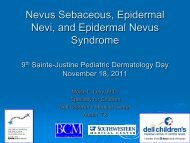Idiopathic Scoliosis - CHU Sainte-Justine - SAAC
Idiopathic Scoliosis - CHU Sainte-Justine - SAAC
Idiopathic Scoliosis - CHU Sainte-Justine - SAAC
You also want an ePaper? Increase the reach of your titles
YUMPU automatically turns print PDFs into web optimized ePapers that Google loves.
<strong>Idiopathic</strong> <strong>Scoliosis</strong><br />
Update in management in 2012<br />
Stefan Parent, MD, PhD.<br />
Academic Chair in Pediatric Spinal<br />
Deformities of <strong>CHU</strong> Ste-<strong>Justine</strong><br />
SPORC 2011
<strong>Idiopathic</strong> <strong>Scoliosis</strong><br />
• Affects 2-3% of the population<br />
• The most common form is adolescent idiopathic scoliosis<br />
• Affects primarly adolescent females<br />
• Still remains of uncertain etiology<br />
• Genetic factors<br />
• Hormonal factors<br />
• Abnormal biomechanical forces<br />
• Connective tissue abnormalities<br />
• Neuro-physiologic predisposition
Prevalence<br />
• 0.5-3% for curves greater than 10°<br />
• 1.5 – 3 per 1000 for curves greater than 30°<br />
• Small to moderate curves are common<br />
• Severe curves requiring treatment are rare<br />
• Boys and girls equally affected for minor curves<br />
• Larger curves: girls:boys = 8:1
Etiological factors<br />
JBJS A 2000; Lowe et al.
Known progression factors<br />
• Age (skeletal maturity)<br />
• Sex<br />
• Initial Cobb angle<br />
• Peak growth velocity<br />
• Family history
Age<br />
• AKA skeletal maturity<br />
• Tri-radiate cartilage closure<br />
• Risser sign<br />
• Menarchal status<br />
Menses usually start 6-12 months after peak<br />
growth velocity
Copyright © restrictions apply.<br />
Plot of height velocity curve with median occurrence of menarche, age at menarche plus two years,<br />
and Risser grades 1, 4, and 5 in the 120 female patients with idiopathic scoliosis<br />
Little, D. G. et al. J Bone Joint Surg Am 2000;82:685
• Rapid acceleration phase in AIS corresponds to<br />
time between Risser 0 with triradiate cartilage<br />
closed and Risser 1.
Incidence of curve progression based on age at presentation<br />
and curve size<br />
Lonstein JE, Carlson JM. JBJS (A) 1984
Treatment options<br />
• Observation<br />
• Brace treatment<br />
• Surgical treatment
Yes<br />
Patient presenting with scoliotic curve<br />
11 - 25 ° 25 - 45 ° > 40-50<br />
Skeletal maturity °<br />
Skeletal maturity<br />
No<br />
Yes No<br />
Consider Surgical<br />
intervention<br />
F-U<br />
PRN<br />
F-U until<br />
skeletal maturity<br />
every 6-12<br />
months<br />
F-U every 5<br />
years to assess<br />
progression<br />
Consider bracing<br />
F/U q4-6 months<br />
Adapted from Parent, Newton et al. ICL 2005
Observation<br />
• Usually reserved for mild curves (less than 20°)<br />
• Mild to moderate curve at physical maturity<br />
(below 40°)<br />
• Patient preference
Lorenz, circa 1920<br />
Hippocrates (460-377 BC)<br />
Conservative<br />
Treatment !!<br />
Le Mesurier, 1940<br />
Cotrel, 1960
Bracing<br />
• In growing children (pre-teen and adolescents)<br />
• Documented curve progression to 25-30° (SRS)<br />
• Different types<br />
• Problems with compliance<br />
• Prevents 90% of curves from progressing when<br />
worn > 16 hours<br />
• Allington et al. JBJS(A) 1996 and Green JBJS(A) 1986<br />
• Not practical after skeletal maturity
Bracing<br />
• Thoraco-lumbo-sacral orthosis (TLSO)<br />
• Several types available<br />
• Boston underarm brace most popular among North<br />
American surgeons for adolescent idiopathic scoliosis<br />
• Must be worn at least 16 hours/day to have an effect<br />
• Effective for double major curves and simple thoracic<br />
and lumbar curves<br />
• Not as effective for high thoracic curves
Boston Brace
Bracing<br />
• Nighttime bending braces<br />
• Charleston and Providence designs<br />
• Work by overcorrecting the spinal deformity<br />
• Probably as effective in preventing progression in<br />
single lumbar and thoraco-lumbar curves as Boston<br />
brace<br />
Howard et al. Spine 1998<br />
• Boston brace found to be more effective for other<br />
types of curves than nighttime bending brace<br />
Howard et al. Spine 1998 and Katz et al. Spine 1997
Price C et al, Nighttime bracing for AIS with the Charleston bending brace:<br />
long term follow-up, JPO, 17:703-707, 1997
Surgery<br />
• Goal is to improve spinal balance and alignment and<br />
prevent further progression<br />
• Indications based on:<br />
• Curve magnitude (usually > 40-50°)<br />
• Clinical deformity (rib prominence)<br />
• Skeletal maturity<br />
• Curve pattern<br />
• Risk for progression
Indications for surgical treatment<br />
• During growth<br />
• Curve > 45-50%<br />
• Progressive thoracic deformity<br />
• Trunk imbalance<br />
• Failed brace treatment<br />
• After end of growth<br />
• Curve > 50%<br />
• Progressive deformity<br />
• Intractable pain
Current trends in surgery<br />
• Fuse short and instrument a lot!!!<br />
• Increasing posterior vs. Decreasing anterior<br />
• Segmental instrumentation provides better curve<br />
correction<br />
• Thoracic pedicles screws are « state-of-the-art »<br />
• Thoracoscopic procedures have re-defined role
Surgery Goals<br />
• Balanced spine<br />
• Avoid fusing unnecessary levels<br />
• Provide long-term pain relief<br />
• Improve cosmesis<br />
• Prevent cardio-pulmonary decompensation
Thoracoscopic procedures<br />
• Thoracoscopic anterior release and fusion<br />
• Reserved for curves between 70° to 100°<br />
• Under 70°, use posterior approach only<br />
• Over 100°, anterior release through open<br />
thoracotomy<br />
• Thoracoscopic anterior scoliosis instrumentation + fusion<br />
• Provides good cosmetic results in selected patients<br />
• Long and steep learning curve<br />
• Potentially less damage to the chest wall musculature<br />
than open approach and avoids damage to paraspinal<br />
musculature
Thoracoscopic Exposure
Discectomy/Fusion
New strategies for correction<br />
• Direct vertebral derotation (DVD)<br />
• VCM (Vertebral column manipulation)<br />
• Direct apical vertebral derotation (DAVD)<br />
• All based on the correction of thoracic<br />
deformity using pedicle screw anchors
Minimally Invasive surgery<br />
• New trend in deformity<br />
surgery<br />
• Long instrumentation<br />
now possible through<br />
small incisions<br />
• Fusion relies on facet<br />
fusion<br />
• Long-term outcome
Minimally invasive treatment<br />
Courtesy F. Miyanji
Summary<br />
• <strong>Scoliosis</strong> remains of uncertain etiology<br />
• Curve progression is difficult to assess<br />
• Treatment options include observation, bracing<br />
and surgery
Summary<br />
• Bracing to prevent progression<br />
• Different types of orthoses available<br />
• Surgery to correct spinal deformity and obtain<br />
balanced, pain-free spine



